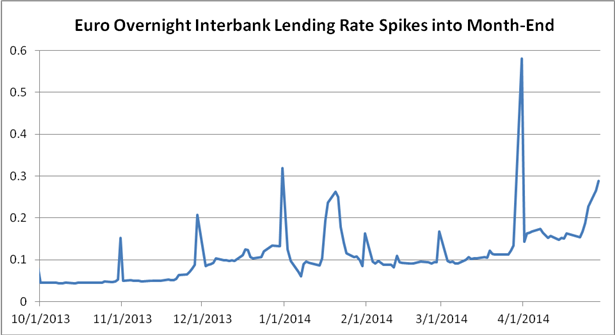Why are Euro Rollover Rates so High?
The end of the month has produced a sharp jump in overnight interbank lending rates (LIBOR) in Euros, and the fact that today sees rollover charges/credits at four times their normal rate magnifies the effect.

Data source: British Banking Association
Indeed holding a Euro/US Dollar short position on the interbank market has become almost four times more expensive than it was yesterday. The chart below shows funding conditions are now at their most stretched since the surge we saw into the end of the first quarter.

Source: Bloomberg Generic Price - “Consensus” Pricing
Understanding Forex Rollover
Trading forex on leverage involves borrowing one currency in order to purchase another. In effect this means traders will pay interest rates for the currency which they sell, while they receive interest rate payments for the currency which they buy. In FX terminology this is most often called “Rollover” or “Swaps”.
Overnight interest rates will guide whether the trader will ultimately pay to hold a position or earn interest on the trade, and any sharp changes in the supply or demand for a specific currency can shift overnight interest rates in a hurry.
This dynamic can be very seamless to the trader, and indeed the parent company of DailyFX in FXCM Inc. posts the Rollover rates for both “Buy” and “Sell” orders directly on their trading platform.
End of the Month Spike in Interest Rates Combines with 4x Rollover Day due to Holiday
We often see such sharp supply and demand imbalances at important dates in the calendar year—namely months, quarters, and years. In this case the jump in rates coincides with the end of the month of April, and the fact that May 1 is a holiday across the Euro Area means that the weekend rollover charges/credits will be paid or charged on a single day.
Traders should note that this means interest rate charges/credits will be far larger than normal for holding Euro short positions.
It is likewise important to point out that we are in the middle of Japan’s Golden Week—a series of holidays at the end of April and through early May. Though forward rates are thus far relatively normal, traders should take note of our Rollover Calendar and the holiday schedule for JPY pairs.
Recommended Content
Editors’ Picks
EUR/USD holds below 1.0750 ahead of key US data

EUR/USD trades in a tight range below 1.0750 in the European session on Friday. The US Dollar struggles to gather strength ahead of key PCE Price Index data, the Fed's preferred gauge of inflation, and helps the pair hold its ground.
GBP/USD consolidates above 1.2500, eyes on US PCE data

GBP/USD fluctuates at around 1.2500 in the European session on Friday following the three-day rebound. The PCE inflation data for March will be watched closely by market participants later in the day.
Gold clings to modest daily gains at around $2,350

Gold stays in positive territory at around $2,350 after closing in positive territory on Thursday. The benchmark 10-year US Treasury bond yield edges lower ahead of US PCE Price Index data, allowing XAU/USD to stretch higher.
Bitcoin Weekly Forecast: BTC’s next breakout could propel it to $80,000 Premium

Bitcoin’s recent price consolidation could be nearing its end as technical indicators and on-chain metrics suggest a potential upward breakout. However, this move would not be straightforward and could punish impatient investors.
US core PCE inflation set to signal firm price pressures as markets delay Federal Reserve rate cut bets

The core PCE Price Index, which excludes volatile food and energy prices, is seen as the more influential measure of inflation in terms of Fed positioning. The index is forecast to rise 0.3% on a monthly basis in March, matching February’s increase.